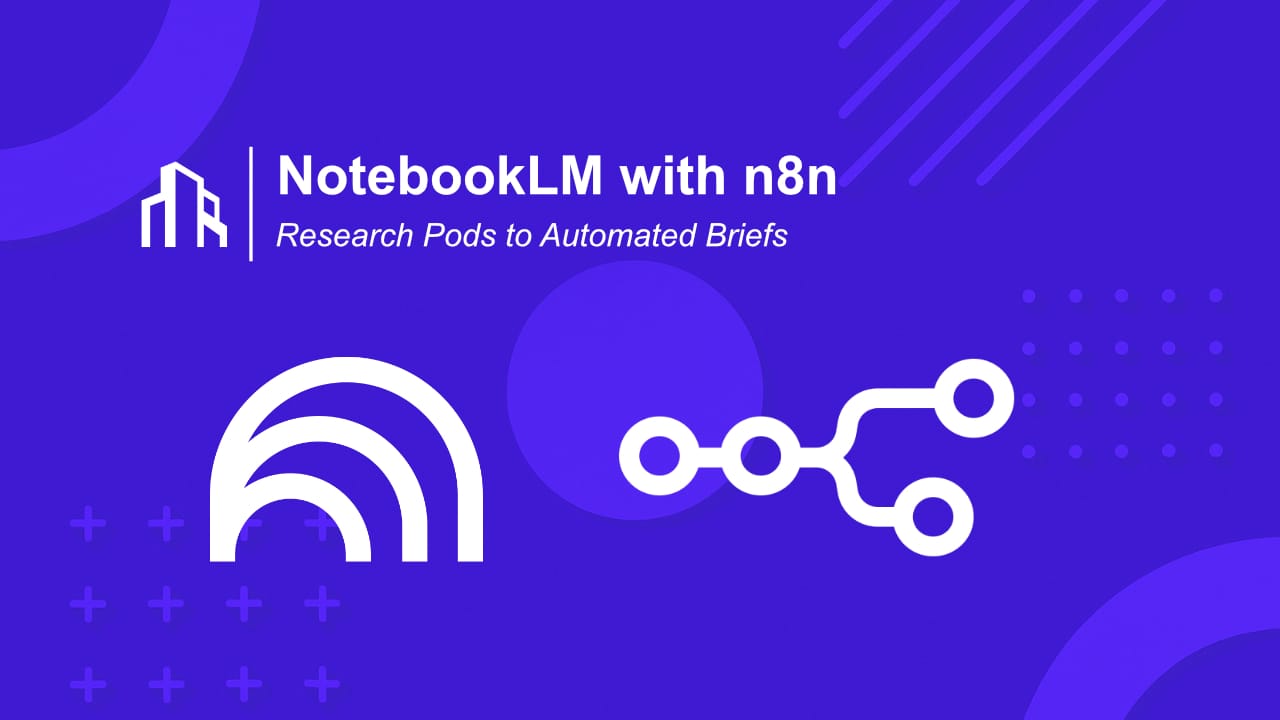NotebookLM with n8n: From Research Pods to Automated Briefs
Turn Google’s NotebookLM into a workflow engine. Learn how to connect it with n8n to automate research, build smart briefs, and save hours every week.

NotebookLM is quietly reshaping how teams capture, organize, and summarize knowledge. But while Google’s AI note-taking system excels at contextual understanding, it stops short of full automation. That’s where n8n enters the picture.
By connecting NotebookLM to n8n, you can transform passive AI summaries into dynamic, recurring briefs automated reports that build themselves from your research pods, documents, and chat transcripts. This integration bridges the gap between static knowledge and living intelligence.
Let’s Map Your NotebookLM Workflow
Get a quick assessment of how NotebookLM and n8n can streamline your knowledge workflows.
What NotebookLM Does (and Doesn’t)
NotebookLM turns structured and unstructured text such as PDFs, meeting notes, and emails into an interactive notebook powered by Google’s AI models. It can summarize, answer context-specific questions, and extract insights across multiple sources.
But it isn’t a workflow engine. It won’t automatically distribute those insights to your CRM, generate a daily digest, or push data to your project management stack. Without external automation, NotebookLM remains a siloed research assistant.
That’s where n8n steps in.
Why Combine NotebookLM with n8n
n8n is an open automation platform that lets you orchestrate data across APIs, cloud apps, and AI tools without writing full custom code. Integrating n8n with NotebookLM opens up entirely new workflows:
- Auto-generate briefs from newly added research pods.
- Trigger notifications in Slack or email when summaries update.
- Feed structured outputs into Notion, Airtable, or HubSpot.
- Schedule periodic re-summaries when your dataset evolves.
- Tag and classify insights using AI classifiers inside n8n before archiving.
Together, they enable a continuous research loop collect, summarize, automate, distribute.
Example Workflow: From Source to Brief
Here’s a realistic sequence built inside n8n:
- Trigger: A new file or note is added to a shared Google Drive folder linked to NotebookLM.
- Process: n8n calls the NotebookLM API (or an intermediate webhook) to retrieve updated summaries.
- Refine: A GPT-based node rewrites the content into a concise “executive brief.”
- Store: The brief is sent to Airtable, categorized by topic, and versioned automatically.
- Distribute: n8n posts a summary in Slack and generates a new entry in Notion or a custom dashboard.
The result: every new research input automatically becomes a polished, shareable insight within minutes.
Use Cases That Deliver Measurable ROI
1. Internal Research Briefing
Teams compiling competitive or market research can have NotebookLM produce the initial synthesis, while n8n structures and archives it eliminating hours of manual copy-pasting.
2. Client Reports and Thought Leadership
Agencies can push client-specific notebooks through n8n to create ready-to-publish summaries or blog drafts.
3. Academic and Knowledge Management
Universities and research departments can automate weekly summaries of large document sets, with traceable metadata and authorship logs.
4. Product Documentation
Product teams can integrate NotebookLM with repositories and generate AI-refreshed documentation synced to version control or Notion pages.
Integrating NotebookLM with n8n (Practical Setup)
While NotebookLM doesn’t yet provide an official API, you can leverage custom connectors or Google Apps Script webhooks as middleware between the two systems.
Typical architecture:
- Webhook Node (n8n): Receives JSON payloads from NotebookLM updates or Drive triggers.
- Data Transformation Node: Parses document metadata and content.
- AI Node (OpenAI, Anthropic, or local LLM): Refines summaries or categorizes insights.
- Storage Node: Sends the structured output to Airtable or a database.
- Notification Node: Posts updates to Slack or via email.
Scalevise often implements this setup using a secure middleware layer with audit logs and API throttling to prevent runaway executions.
Governance and Security Considerations
When automating data from NotebookLM, keep governance top of mind:
- Access Control: Only trigger flows from verified sources (e.g., whitelisted Drive folders).
- PII Protection: Redact sensitive information before pushing content downstream.
- Audit Logging: Use n8n’s built-in execution logs or connect to a SIEM via webhook for compliance.
- SSO and Encryption: Implement OAuth 2.0 tokens and encrypted credentials when bridging systems.
Automation must accelerate not endanger your data lifecycle.
Measuring Impact: From Hours Saved to Insights Delivered
The real advantage of NotebookLM + n8n isn’t novelty it’s efficiency. Teams typically report:
- 70–90% reduction in manual summarization time.
- Seamless version control between research notes and published deliverables.
- Consistent structure across all knowledge outputs.
- Increased discoverability of internal research assets.
By turning AI summaries into automated briefs, you don’t just save time you standardize intelligence.
Why This Matters for Modern Knowledge Workflows
AI knowledge systems are moving from retrieval to reasoning to automation. NotebookLM represents the reasoning layer; n8n provides the automation layer. When connected, they form a true agentic workflow an intelligent loop that contextualizes and acts without manual prompting.
It’s a tangible step toward scalable operational intelligence: knowledge that writes, updates, and distributes itself.
How Scalevise Helps
Scalevise designs, implements, and maintains automation architectures that combine AI reasoning tools like NotebookLM with robust workflow platforms like n8n, Make.com, and custom middleware. We ensure your automations are secure, compliant, and fully auditable.
If you want to integrate NotebookLM into your operational workflows or develop your own AI knowledge system? Schedule a call with us:
